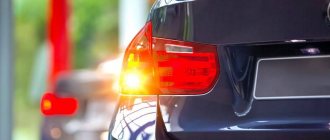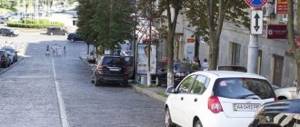- November 26, 2018
- Automobile law
- Mazalova Olga
Every year there are more and more road users. In this regard, the government has to introduce new restrictions, increase parking costs, or completely prohibit stopping in certain places. This especially applies to large cities, where illegally parked vehicles can often create a large traffic jam.
Of course, after 30 minutes of wandering around looking for a parking spot, you want to break all the rules. Should not be doing that. Every sign on the road is placed for a reason, and perhaps the car will interfere with pedestrians or other vehicles. The offense is punishable by a fine and, in some cases, towing of the vehicle.
Signs and road markings
To properly stop the car, the driver must follow signs, road markings, and traffic rules.
If a motorist sees on the road a round sign with a blue background, which depicts a red circle with two crossed out stripes, then he should not stop in this area. This is what the traffic rules article says. Stopping in the wrong place is punishable by a hefty fine, so every driver should carefully monitor the signs.
Sometimes you can see a sign underneath them indicating a certain period. At this time, you should not stop at a specific area. During other periods, any type of transport can stop without fear.
Also on the sign below the sign you can sometimes see vehicles that are subject to the rule. A solid yellow line along the edge of a road or curb also tells motorists not to stop or park there.
Coverage area
In order for the driver not to receive a fine for stopping in the wrong place, he must know the traffic rules well. The “No Stopping” sign applies only to the area after it and only to the side of the road on which it is installed. It turns out that the vehicle stopped in front of him does not violate any rules.
Sometimes you can see a sign under the sign that indicates the duration of the action. If such additional information is not observed, then the sign ceases to be valid:
- At the crossroads.
- After the sign “End of all restrictions zone”. It is a round white sign with a black circle and four black stripes.
- After the end of the settlement.
- At the beginning of the village.
When can you stop under a no-stop sign?
A fine for a stop sign is prohibited; it is issued only in cases where a serviceable car has stopped under it.
A car, like any other equipment, is subject to unexpected breakdowns. In such situations, the driver does not have the opportunity to choose where exactly to park. Cases in which a driver can make an emergency stop in an undesignated place include:
- There is a malfunction in the car's brake system.
- Car steering part malfunction.
- Malfunction of rear lights, headlights.
- The windshield wiper malfunctions if the car is driven during precipitation.
These situations are grounds for immediately stopping the car, even if such parking occurs in a place not intended for this purpose.
A fine for stopping in the wrong place is not issued in situations where the driver was moving in a direction from which it is impossible to see this sign.
The driver has the right to stop his car in front of a sign prohibiting stopping, only on the condition that by such a stop he does not violate other traffic rules (for example, does not interfere with other road users).
Where should you not stop?
To avoid getting a fine for stopping in the wrong place, you need to know exactly where stopping your car violates the law.
List of places:
- At the pedestrian crossing, as well as for 5 meters in front of it. After it, cars can stop without fear of getting a fine.
- On or near tram tracks. This rule is also very logical. The tram cannot leave the tracks, and therefore cannot bypass any traffic that interferes with it.
- On a dedicated lane. This refers to special places for bicycles, as well as lanes along which public transport moves.
- At intersections, as well as at a distance of 5 meters from the edge of the roadway.
- In places where the driver creates an obstacle to the movement of pedestrians.
- It is prohibited for a car to block traffic lights or signs for other road users.
- The driver will be fined if his car interferes with the exit or entry of other cars.
- On roads where the distance from a solid line to a car is 3 meters or less. Please note that we are talking specifically about a continuous dividing strip.
- On the road, if there is a dangerous turn nearby. In this case, an emergency situation may arise.
- On the roadway where visibility is below 100 meters. A major accident is possible if one car enters the oncoming lane to avoid another.
- In places that are specially designated for parking for disabled people.
- At stops (except for stops for boarding and disembarking passengers, if this does not interfere with the movement of route vehicles or vehicles used as passenger taxis).
- On bridges and overpasses.
- In the tunnels. Visibility is quite low here and there is no room for maneuver.
- At railway crossings, as well as near them.
- When driving on the main road, you should not stop if the driver has left the populated area.
You can get a fine not only for stopping. Parking in the wrong place is also punishable. In addition to the previously listed places, you cannot park a car on lawns, in courtyard areas in front of doors and gates, as well as near railway lines.
Where else is stopping prohibited?
In addition to tram tracks, stopping vehicles is prohibited according to traffic regulations on other road sections:
- On bridges, overpasses, overpasses. You can stop here for no more than 5 minutes if there are at least three lanes of passing traffic;
- On the road, if the distance from the edge of the car to the solid marking line is less than 3.5 m: this will create obstacles for other road users;
- At pedestrian crossings and closer than 5 meters to them. Both stopping and parking are prohibited: the presence of a car in these areas causes inconvenience to pedestrians and increases the likelihood of an accident;
- In areas with limited visibility;
- At road crossings and crossroads;
- In the area covered by the prohibition sign.
By complying with traffic rules, you can prevent administrative liability.
If a fine for stopping on tram tracks is nevertheless issued, it is reflected in the resolution, and the payment period is 60 calendar days. Tram tracks - fine!
Penalties for public transport drivers
Stopping a bus in the wrong place is also punishable by fines. In this case, you will have to pay 3,000 rubles. Typically, such orders from the traffic police are received by minibus taxis, which stop at the request of passengers. In case of repeated violation, penalties will increase to 5,000 rubles.
Not only stopping a bus in the wrong place is punishable. You can also receive a fine if you park at night in non-designated areas. The driver will have to pay 5,000 rubles to the state.
It is worth noting that the listed fines are issued not by traffic police officers, but by employees of state transport supervision, as well as representatives of state control in the field of passenger transportation.
Stop in the yard
Unfortunately, the only way to force drivers not to break the law is through fines. Violation of parking rules in Moscow and St. Petersburg entails a fine of 3,000 rubles. The law does not provide for forced evacuation of the car in this case. All that remains for the traffic police officers is to issue a fine to the violator. Stopping in other cities also entails a fine of 1,500 rubles.
In order not to receive sanctions, the driver only needs to follow several rules:
- Do not park the car with the engine running near the windows of a high-rise building.
- Do not block the exits and entrances to the entrance, as well as to the service parts of the building with a car.
- Do not interfere with traffic.
- Do not impede access to the entrance of emergency services.
- Do not obstruct access to trash cans. It is allowed to stop the car at a distance of 5 meters from the containers.
Amount of fine for stopping on tram tracks
According to Part 3.2 of Art. 12.19 of the Code of Administrative Offenses of the Russian Federation, the fine for obstructing the movement of trams is 1,500 rubles. For such a violation in Moscow or St. Petersburg you will have to pay twice as much, i.e. 3,000 rub.
The violation can be recorded by the traffic police inspector himself, by specialized devices, or by citizens by taking photographs and sending them to the traffic inspectorate through an application for filing electronic complaints - this is usually available in every city: for example, the “Active Citizen” application. After considering the appeal, the inspector will issue a decision, and the violator will have to pay a fine.
Note! Some cities have tram lines, but they are not used. Despite the fact that the driver will not actually cause any inconvenience to anyone due to the stop, it is still not recommended to stop at them: according to the Code of Administrative Offenses of the Russian Federation, a fine will have to be paid regardless of whether obstacles were created to the movement of trams or not.
Stopping on the sidewalk
You should not block the movement of pedestrians on the sidewalk with your car. Stopping in the wrong place in Moscow and St. Petersburg can result in a fine of 3,000 rubles. Penalties in other cities amount to 1,000 rubles.
If there are markings, as well as a permit sign, you can stop according to the following rules:
- A collision with only the front wheels on the pavement.
- Hitting with rear wheels only.
- Stopping the vehicle in accordance with the sign.
- Collision with two right wheels.
- Collision with two left wheels.
If drivers are not afraid of the size of the fine for stopping in the wrong place, then representatives of the State Traffic Inspectorate can also take the car to the impound lot.
Differences between stopping and parking
First of all, let's look at the difference between the concepts of stopping and parking.
This will allow us to consider the rules for each of the maneuvers separately in the future. To put it as simply as possible, these concepts differ in their duration. Stopping is a short maneuver, and parking is a long maneuver. However, these are not all their differences, so let’s turn to paragraph 1.2 of the traffic rules:
“ Stop ” is a deliberate stop in the movement of a vehicle for up to 5 minutes, as well as for longer if this is necessary for boarding or disembarking passengers or loading or unloading the vehicle.
“ Parking ” is the intentional cessation of movement of a vehicle for a period of more than 5 minutes for reasons not related to the embarkation or disembarkation of passengers or the loading or unloading of the vehicle.
First of all, both stopping and parking are a deliberate cessation of movement, that is, they are carried out at the request of the driver. They should not be confused with stopping traffic in accordance with traffic regulations (for example, to let pedestrians pass at a crossing) and with a forced stop:
What is a forced stop?
Intentionally stopping the movement of a vehicle is a stop in two cases:
- If the car has not moved for less than 5 minutes. It does not matter what the driver and passengers were doing at that time.
- If the vehicle has stopped to pick up or unload passengers or to load or unload cargo. In this case, the duration of the maneuver does not matter.
All other intentional traffic stops (lasting 5 minutes or more and not related to boarding passengers or unloading cargo) are considered parking .
| Duration less than 5 minutes | Duration more than 5 minutes | |
| Passengers are boarding/disembarking or cargo is loading/unloading | stop | stop |
| There is no boarding/disembarking of passengers or loading/unloading of cargo | stop | parking |
Once again about the duration of the maneuver. 4 minutes 59 seconds – stop. 5 minutes 0 seconds – parking.
Once again about loading/unloading cargo. If the driver goes out to smoke for 10 minutes, then there is a parking lot. If the driver went out to smoke for 10 minutes and took a stool (load) from the trunk for convenience, then a stop occurs.
Stopping and parking on the lawn
Every motorist should know that issuing a fine for this offense is not carried out by the State Traffic Inspectorate, but by the city improvement inspectorate.
Of course, the driver cannot always fully assess whether the stopping area is a lawn. It is especially difficult not to break the rules in winter, when behind a layer of snow it is not clear whether the asphalt is finished. Therefore, most often lawns are fenced with special borders.
The driver will be required to pay a fine. How many stops in the wrong place a driver makes, so many orders can come. The amount of the fine depends on the damage caused to the lawn, as well as the status of the owner. For example, a fine of 3 thousand rubles may be issued to an individual. A legal entity will pay more. The maximum fine is 500 thousand rubles.
Forced stop in the wrong place, received a fine. What to do?
Parking in the wrong place is a common and multifaceted violation that, perhaps, every motorist has encountered in big cities. Illegal stopping and parking are regulated by Articles 12.16 and 12.19 of Chapter 12 of the Code of Administrative Offences.
But it’s one thing when a driver breaks the rules consciously or out of ignorance (the latter, as you know, does not relieve responsibility), and quite another when the stop is forced, for example, a breakdown. A forced stop is not a violation; the law does not provide for punishment for this.
Drivers often receive fines for illegal stopping or parking in automatic mode, from photo and video cameras. A common situation, unfortunately, that any motorist can encounter on the road, especially in a city where many photo and video cameras are installed.
A similar situation occurred with a car owner in Moscow, who received a fine for parking in a prohibited place due to the fact that she had a tire puncture on the way. The motorist stopped the car, turned on the hazard warning lights, put up a warning triangle, but this did not save her from a fine, which according to the law should not have been, because in each specific case of stopping the vehicle, the inspector looks through photographs of the violation manually in order to make a final verdict , is obliged to carefully consider whether there was really a violation or not.
In life it turns out a little differently, as experts note on the pages of the Kommersant Publishing House:
“The problem is the large volume of photographs from cameras, which inspectors spend only a few seconds processing, without having time to examine all the circumstances of the violation in the photo.”
The pages of the publication provide a detailed example of a situation in which a lady driver complied with all the rules for a safe forced car stop due to a sudden breakdown, but still received an impressive fine of 3 thousand rubles from the Moscow Administrative Road Inspectorate (MADI). The fine was issued based on footage from a photo and video camera.
And this is despite the fact that the photograph from a stationary camera clearly shows an emergency stop sign, as explained in the publication.
Reasonable questions arise: how to avoid a fine from a camera during a forced stop and what to do if a fine from a camera does arrive?
Stopping the car in the second row
According to the Traffic Rules, stopping and parking of four-wheelers is allowed only in one row. The only exceptions are extended sections of the road - special “pockets” or parking lots. The reason for such rules is clear - cars will interfere with other vehicles, causing traffic jams and accidents. What fine for stopping in the wrong place will be issued by the traffic police depends on the city. For residents of the capital and St. Petersburg it is 3 thousand rubles, for other cities it is 1500 rubles.
Fine for parking in the wrong place
Based on the Code of Administrative Offenses of the Russian Federation, Part 4 of Art. 12.16 for failure to comply with road markings and signs prohibiting parking, a motorist faces punishment - a fine of 1.5 thousand rubles. Exceptions are offenses recorded in St. Petersburg and Moscow. In cities at the federal level, the fine for parking in the wrong place reaches 3 thousand rubles .
Most parking lots have been reclassified from free stops to paid parking. But many motorists are not satisfied with the cost of space for a car and they refuse to pay the fee, breaking the law, for which they face the risk of having their car towed. Here the car owner will have to pay a fine, as well as 5 thousand rubles for tow truck services and deposit 200 rubles. for every hour of parking.
Stopping in areas designated for disabled drivers
Disabled motorists have some advantages when parking and stopping a vehicle. As a rule, places are allocated for them in close proximity to the entrances to buildings. The state is trying to make life easier for these people, because it is not always possible to find a parking space, and it is often located very far from the entrance. If it is not at all difficult for a physically healthy person to reach the final destination, then for disabled people this path is really not easy.
Unfortunately, not all drivers understand the situation, or maybe they simply don’t know the traffic rules. Such violators will have to pay a fine of 5 thousand rubles. In some cases, traffic police officers may call a tow truck.
Payment of fines and discounts
On the State Services portal, as well as on the website of the State Traffic Inspectorate, each driver can check whether he has been assessed any penalties. In addition, receipts always arrive by email to the car enthusiast. If the fine is not paid within 60 days, penalties may be assessed. When towing a car, you will also have to pay extra for the tow truck, as well as for the car being in the impound lot. You should not delay paying the fine for stopping in the wrong place. Payment within 20 days from the date the receipt is issued gives a 50 percent discount, which significantly reduces the total payment amount.
How to appeal a fine for stopping in the wrong place?
If the driver does not agree with the fine issued, he can always challenge it. Each motorist has a ten-day period to appeal the decision. True, you will need to identify an error, for example, a time or date discrepancy, incorrect application of traffic rules, etc. The complaint may be filed at a later date. Then, along with it, you will need to write a statement indicating a valid reason why the complaint was not filed in a timely manner.
The complaint is filed with the traffic police department where the decision was issued, or with the court at the location of the traffic police authority. Within 10 days after this, the driver must receive a response from the traffic police. If the complaint was filed with the court, the response will be received within two months.
When filing a complaint with the authorities, it is better to take care of witnesses, video from the recorder or other evidence of innocence in advance. Often vehicle owners are simply afraid to file a complaint, but in vain. In judicial practice, there have been many cases when drivers won the case. Traffic police officers are the same people who can sometimes make mistakes and misinterpret the situation.
Don't break traffic rules. Even if the driver is not afraid of losing some money and time to pay fines, it is worth thinking about the fact that the rules were invented for a reason. There are other road users, as well as pedestrians, whose movement is impeded by an illegally parked vehicle.
What is the fine for stopping under a “No Stopping” sign in 2021?
The rules determining where a vehicle can be stopped and parked are specified in the traffic rules, and the punishment for violating them is regulated by Article 12.19 of the Code of Administrative Offences.
The sanctions applied depend on whether it was a simple violation or whether it also created obstacles for other drivers.
In paragraph 1 of Art. 12.19 of the Code of Administrative Offenses states that for failure to comply with the rules of stopping and parking, the offender is given a fine of 500 rubles.
However, stopping or parking under this sign may be more than just a traffic violation. This action may cause interference to other road users. Then the fine will be equal to 2000 rubles, according to paragraph 4 of the same article.
In cities of federal significance (and Moscow and St. Petersburg are such) other rules apply, based on clauses 5 and 6, respectively:
- fine for a primary violation of 2,500 rubles;
- when creating interference and obstacles - 3000 rubles.










